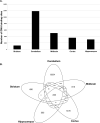Candidate variants in TUB are associated with familial tremor
- PMID: 32956375
- PMCID: PMC7529431
- DOI: 10.1371/journal.pgen.1009010
Candidate variants in TUB are associated with familial tremor
Abstract
Essential tremor (ET) is the most common adult-onset movement disorder. In the present study, we performed whole exome sequencing of a large ET-affected family (10 affected and 6 un-affected family members) and identified a TUB p.V431I variant (rs75594955) segregating in a manner consistent with autosomal-dominant inheritance. Subsequent targeted re-sequencing of TUB in 820 unrelated individuals with sporadic ET and 630 controls revealed significant enrichment of rare nonsynonymous TUB variants (e.g. rs75594955: p.V431I, rs1241709665: p.Ile20Phe, rs55648406: p.Arg49Gln) in the ET cohort (SKAT-O test p-value = 6.20e-08). TUB encodes a transcription factor predominantly expressed in neuronal cells and has been previously implicated in obesity. ChIP-seq analyses of the TUB transcription factor across different regions of the mouse brain revealed that TUB regulates the pathways responsible for neurotransmitter production as well thyroid hormone signaling. Together, these results support the association of rare variants in TUB with ET.
Conflict of interest statement
I have read the journal's policy and the authors of this manuscript have the following competing interests: MPS is a co-founder of Personalis, Qbio, Sensomics and January. He is on the scientific advisory of these companies and Genapsys.
Figures






References
Publication types
MeSH terms
Substances
Grants and funding
LinkOut - more resources
Full Text Sources
Molecular Biology Databases

